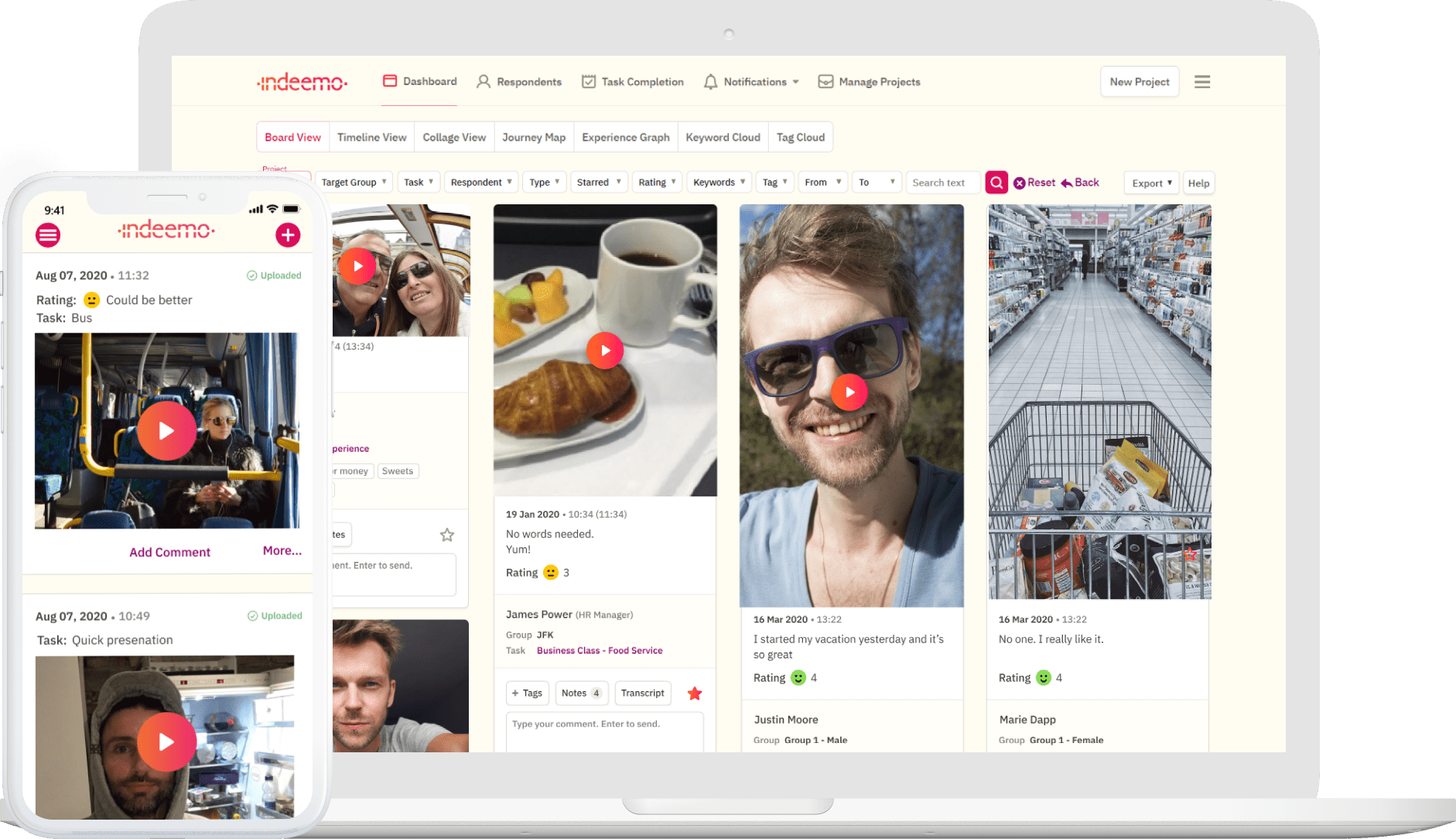What is Mobile Ethnography?
Mobile Ethnography, sometimes referred to as Digital Ethnography or Autoethnography, is the methodology by which Researchers observe recruited Respondents who use smartphones to journal their everyday lives, behaviours and feelings (using photos, videos or notes) in relation to a particular research topic.
Smartphones, Video over 4G, All-You-Can-Eat data packages and the explosion of social networking and messaging apps have led to the growing adoption of Mobile Ethnography as a methodology.
Mobile Ethnography is a non invasive technique which enables Researchers to simultaneously observe the everyday lives of multiple respondents in multiple locations at a fraction of the cost of traditional ethnography.
How does Mobile Ethnography differ from traditional Ethnography?
In traditional Ethnography, Researchers typically immerse themselves in the lives of their respondents for a period of time.
Traditional Ethnography involves Researchers being physically present with the respondents for prolonged periods of time so that they can observe the rituals, routines and culture of the Respondents to gain a deep, firsthand understanding of the Respondent’s everyday lives.
Traditional ethnography has its pros and cons:
First hand observation is the best way to capture authentic, spontaneous, contextual behaviours which can sometimes uncover hidden needs that can yield significant value to the Client who commissions the Ethnographic User Research.
However, traditional Ethnography can be quite expensive as the ratio of observers to respondent is typically 1:1 and sometimes less. Couple this with the costs associated with the Researcher travelling to the respondent’s location, spending hours (or even days) with the respondents and the associated costs of compensation, video recording etc. and it is easy to see why traditional ethnography is beyond the budgets of most clients.
There is the additional concern of the ‘Observer Effect’, which relates to the potential of the respondents to change their behaviours as a result of the presence of the observer. This is particularly amplified in some cultures where traditions relating to hospitality or family position in the presence of a guest may alter their everyday behaviours thereby skewing the results.
More typically however, traditional ethnography involves short-term in-home visits or accompanied shop-alongs that last several hours rather than several days. In these instances, Researchers conduct short term, physically present ethnographies and take field notes to record behaviours, feelings and routines using a fieldwork journal supplemented by videos or photos.
These visits will typically involve some form of in-depth interview to probe and clarify the observations of the researcher.
How does Mobile Ethnography work?
Mobile Ethnography involves recruited respondents using their smartphones to record information (“Ethnographic Data”) about their everyday lives and share that data with Researchers.
Respondents typically post notes, photos or videos (with or without captions) using a mobile ethnography app to create a journal of their lives in relation to the research topic. A video diary study in particular is a really rich source of insights for researchers as they give the researchers the ability to see into the homes or work places of the respondents and observe the natural, contextual, in-the-moment behaviours of the respondent in their own surroundings.
Given the rise in video messaging, we are becoming more comfortable with communicating through video. The act of expressing your opinions using a selfie video is becoming a natural, spontaneous action. In-the-moment video recordings limit the ability of the respondent to self curate what they are doing and as a result, the data that is captured using video skews more towards the reality of the respondents lives compared to what they might tell you if they were writing long form text for example. This gives the data a spontaneous, rich authenticity that may not be achievable using other methodologies.
The Mobile Ethnography app user experience for Respondents is typically a journaling exercise with no interaction between the Researcher and the Respondent. The Respondent captures different moments in their day and shares them with the Researcher as photos with captions, videos, selfie videos or written notes. The contextual nature of the data capture minimises the potential for post rationalisation: if a respondent is recording themselves using your product and tells you what their experience is like, the chances are this is what they are really thinking and feeling.
Alternatively, some Researchers prefer mobile ethnography platforms that offer the ability to interact with the Respondent throughout the course of the fieldwork. This enables the Researcher to remotely interact with the in-context Respondent and probe what the Respondent is doing, thinking and feeling in that moment which can yield an additional layer of understanding.
CASE STUDY
Learn How a Mobile Diary Study can help Food & Beverage brands get closer to Food and Drink consumption moments
Mobile Ethnography: Moderation & Analysis
Analysis and moderation of this data can be quite time consuming and Researchers should factor this into their proposals when responding to client briefs.
Mobile Ethnography can create a lot of unstructured, multimedia ethnographic data in the format of notes, photos or videos. Tagging functionality enables Researchers to code and organise responses into Themes and Concepts. Tags can be assigned on the fly (based on observations made as the data is received) or in line with a predetermined code frame.
Mobile Ethnography Platforms that offer researchers the ability to filter the data by Target / Segment, Respondent or Tag can vastly increase the efficiency of the analysis phase. Automated video transcription coupled with Keyword tools can also speed up the analysis of the data and reduce costs. Displaying the data either as a timeline or a collage can also make it easier for researchers with their analysis and reporting.
Some Researchers like to interact with the Respondent and probe responses during the fieldwork phase. Others prefer not to. The ability for the Researcher to probe responses allows the researcher to clarify the in-context, in-the-moment behaviours and feelings of the Respondent. Platforms that use push notifications ensure probes are delivered instantly to the Respondent’s smartphone.
What are the advantages of Mobile Ethnography compared to traditional Ethnography
Social networking is now entrenched in our lives and messaging is exploding. We’re literally on our smartphone hundreds of times a day. The average amount of time a Facebook user spends on the social network every day is nearing 1 hour. (Source: New York Times)
All of this means that when it comes to communicating and sharing our lives, mobile is our go to platform.
Mobile ethnography apps that leverage our familiarity and comfort with social networking offer several advantages over traditional, in-person ethnographic research, namely:
Due to the fact that the researcher is not physically present, the respondent will typically behave in a more natural way and will be less likely to alter their daily routines to account for the presence of the researcher.
Given our familiarity (and in some cases, addiction) to social networking and messaging apps, documenting and sharing our lives using photos and videos has become a very natural and familiar act. Mobile ethnography apps that leverage a social UX are naturally aligned with this familiarity.
83% of American adults now own cell phones and three-quarters of them (73%) send and receive text messages. In particular demographics, it can be argued that people are now more natural communicating via mobile than they are in person.
As the smartphone is pretty much always with us, mobile ethnography apps that align themselves with our hectic lives and our familiarity with messaging capture more natural behaviours from the respondents’ lives compared to how the respondent might behave in the presence of a stranger.
Ethnographic research apps that support moderator to respondent comments and push notifications enable the researcher to interact with and probe respondents in context and in-the-moment. In particular this can be really powerful in shopper research when it comes to trying to understand point of purchase motivations.
Real time probing using push notifications enables clarification and understanding at a scale and a cost that is not achievable using traditional ethnography.
Behaviours and feelings captured in context, in the moment by respondents are more typically irrational, spontaneous, system-one type behaviours that give researchers a whole new insight to respondents’ irrational behaviours.
The ability to dashboard every photo, video and text response from respondents and analyse these in a structured manner across multiple respondents, segments and possible regions provides a rich layer of data that can yield amazing new insights and in numbers that enable quantitative analysis.
Other Mobile Ethnography research methods
Learn more about all the research methodologies we support.
Upcoming Project?
Need to integrate mobile ethnography into an upcoming project? Contact us now for a free demo and a quote.









